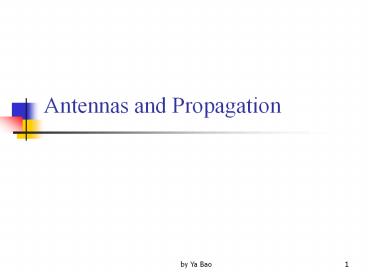Antennas and Propagation - PowerPoint PPT Presentation
1 / 25
Title:
Antennas and Propagation
Description:
Antennas and Propagation – PowerPoint PPT presentation
Number of Views:141
Avg rating:3.0/5.0
Title: Antennas and Propagation
1
Antennas and Propagation
2
Introduction
- An antenna is an electrical conductor or system
of conductors - Transmission - radiates electromagnetic energy
into space - Reception - collects electromagnetic energy from
space - In two-way communication, the same antenna can be
used for transmission and reception
3
Radiation Patterns
- Radiation pattern
- Graphical representation of radiation properties
of an antenna - Depicted as two-dimensional cross section
- Beam width (or half-power beam width)
- Measure of directivity of antenna
- Reception pattern
- Receiving antennas equivalent to radiation
pattern
4
Radiation patterns
5
Types of Antennas
- Isotropic antenna (idealized)
- Radiates power equally in all directions
- Dipole antennas
- Half-wave dipole antenna (or Hertz antenna)
- Quarter-wave vertical antenna (or Marconi
antenna) - Parabolic Reflective Antenna
6
(No Transcript)
7
Antenna Gain
- Antenna gain
- Power output, in a particular direction, compared
to that produced in any direction by a perfect
omnidirectional antenna (isotropic antenna) - Effective area
- Related to physical size and shape of antenna
8
Antenna Gain
- Relationship between antenna gain and effective
area - G antenna gain
- Ae effective area
- f carrier frequency
- c speed of light ( 3 108 m/s)
- ? carrier wavelength
9
(No Transcript)
10
Propagation Modes
- Ground-wave propagation
- Sky-wave propagation
- Line-of-sight propagation
11
Ground Wave Propagation
12
Sky Wave Propagation
13
Line-of-Sight Propagation
14
Line-of-Sight Equations
- Effective, or radio, line of sight
- d distance between antenna and horizon (km)
- h antenna height (m)
- K adjustment factor to account for refraction,
rule of thumb K 4/3
- Maximum distance between two antennas for LOS
propagation
15
LOS Wireless Transmission Impairments
- Attenuation and attenuation distortion
- Free space loss
- Noise
- Atmospheric absorption
- Multipath
- Refraction
- Thermal noise
16
Attenuation
- Strength of signal falls off with distance over
transmission medium - Attenuation factors for unguided media
- Received signal must have sufficient strength so
that circuitry in the receiver can interpret the
signal - Signal must maintain a level sufficiently higher
than noise to be received without error - Attenuation is greater at higher frequencies,
causing distortion
17
Free Space Loss
- Free space loss, ideal isotropic antenna
- Pt signal power at transmitting antenna
- Pr signal power at receiving antenna
- ? carrier wavelength
- d propagation distance between antennas
- c speed of light ( 3 10 8 m/s)
- where d and ? are in the same units (e.g., meters)
18
Free Space Loss
- Free space loss equation can be recast
19
Free Space Loss
- Free space loss accounting for gain of other
antennas can be recast as
20
Categories of Noise
- Thermal Noise
- Intermodulation noise
- Crosstalk
- Impulse Noise
21
Thermal Noise
- Amount of thermal noise to be found in a
bandwidth of 1Hz in any device or conductor is - N0 noise power density in watts per 1 Hz of
bandwidth - k Boltzmann's constant 1.3803 ?10-23 J/K
- T temperature, in kelvins (absolute temperature)
22
Thermal Noise
- Noise is assumed to be independent of frequency
- Thermal noise present in a bandwidth of B Hertz
(in watts) - or, in decibel-watts
23
Noise Terminology
- Intermodulation noise occurs if signals with
different frequencies share the same medium - Interference caused by a signal produced at a
frequency that is the sum or difference of
original frequencies - Crosstalk unwanted coupling between signal
paths - Impulse noise irregular pulses or noise spikes
- Short duration and of relatively high amplitude
- Caused by external electromagnetic disturbances,
or faults and flaws in the communications system
24
Expression Eb/N0
- Ratio of signal energy per bit to noise power
density per Hertz - The bit error rate for digital data is a function
of Eb/N0 - Given a value for Eb/N0 to achieve a desired
error rate, parameters of this formula can be
selected - As bit rate R increases, transmitted signal power
must increase to maintain required Eb/N0
25
Multipath Propagation































